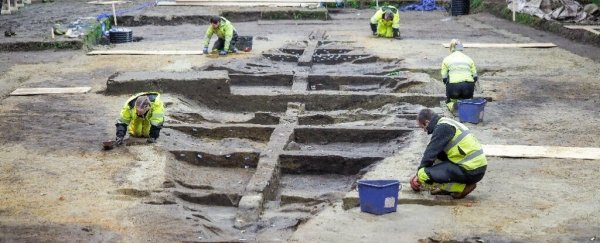Inch by inch, they gently pick through the soil in search of thousand-year-old relics. Racing against on-setting mould yet painstakingly meticulous, archaeologists in Norway are exhuming a rare Viking ship grave in hopes of uncovering the secrets within.
Who is buried here? Under which ritual? What is left of the burial offerings? And what can they tell us about the society that lived here?
Now reduced to tiny fragments almost indistinguishable from the turf that covers it, the 20-metre (65-foot) wooden longship raises a slew of questions.
The team of archaeologists is rushing to solve at least some of the mystery before the structure is entirely ravaged by microscopic fungi.
It's an exhilarating task: there hasn't been a Viking ship to dig up in more than a century.
The last was in 1904 when the Oseberg longship was excavated, not far away on the other side of the Oslo Fjord, in which the remains of two women were discovered among the finds.
"We have very few burial ships," says the head of the dig, Camilla Cecilie Wenn of the University of Oslo's Museum of Cultural History.
"I'm incredibly lucky, few archaeologists get such an opportunity in their career."
Under a giant grey and white tent placed in the middle of ancient burial grounds near the southeastern town of Halden, a dozen workers in high visibility vests kneel or lie on the ground, examining the earth.
Buried underground, the contours of the longship were detected in 2018 by geological radar equipment, as experts searched the known Viking site.
When the first test digs revealed the ship's advanced state of decomposition, the decision was taken to quickly excavate it.
Viking VIP
So far, only parts of the keel have been dug out in reasonable condition.
Analyses of the pieces have determined that the ship was probably raised on land around the ninth century, placed in a pit and buried under a mound of earth as a final resting place.
But for whom? "If you're buried with a ship, then it's clear you were a VIP in your lifetime," Wenn says.
A king? A queen? A Viking nobleman, known as a jarl? The answer may lie in the bones or objects yet to be found – weapons, jewels, vessels, tools, etc – that are typical in graves from the Viking Age, from the mid-eighth to mid-11th centuries.
The site has however been disturbed several times, accelerating the ship's disintegration and reducing the chance of finding relics.
At the end of the 19th century, the burial mound was razed to make space for farmland, entirely destroying the upper part of the hull and damaging what is believed to have been the funeral chamber.
It's also possible that the grave may have been plundered long before that, by other Vikings keen to get their hands on some of the precious burial offerings and to symbolically assert their power and legitimacy.
Animal bones
So far the archaeologists' bounty is pretty meagre: lots of iron rivets used for the boat's assembly, most heavily corroded over time, as well as a few bones.
"These bones are too big to be human," says field assistant Karine Fure Andreassen, as she leans over a large, orange-tinged bone.
"This is not a Viking chief we're looking at unfortunately, it's probably a horse or cattle."
"It's a sign of power. You were so rich that an animal could be sacrificed to be put in your grave," she explains.
Beside the tent, Jan Berge looks like he's panning for gold. He's sifting soil and spraying it with water in hopes of finding a little nugget from the past.
"Make an exceptional find? I doubt it," admits the archaeologist. "The most precious items have probably already been taken. And anything made of iron or organic material has eroded over time or completely disappeared."
But Berge, whose big bushy beard gives him the air of a Viking, is not easily discouraged.
"I'm not here for a treasure hunt," he says. "What interests me is finding out what happened here, how the funeral was carried out, how to interpret the actions of the time."
